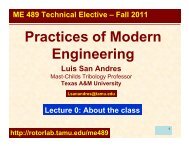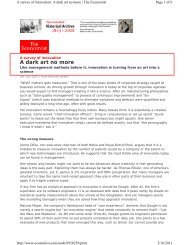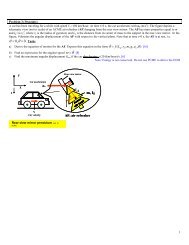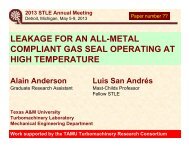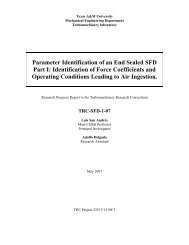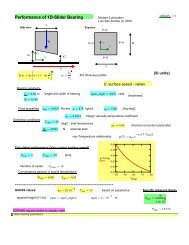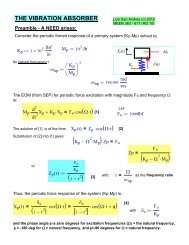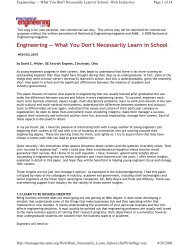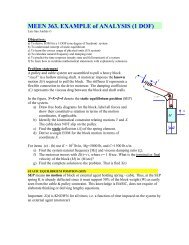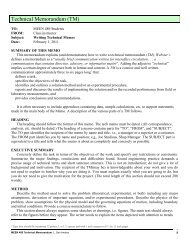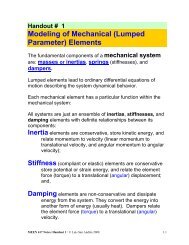F:\WEB site\Teaching MEEN 363 using Dynamics in Engineering ...
F:\WEB site\Teaching MEEN 363 using Dynamics in Engineering ...
F:\WEB site\Teaching MEEN 363 using Dynamics in Engineering ...
Create successful ePaper yourself
Turn your PDF publications into a flip-book with our unique Google optimized e-Paper software.
26 April 2011<br />
Hi,<br />
This note is primarily written for persons who are <strong>in</strong>terested <strong>in</strong> teach<strong>in</strong>g a<br />
<strong>Dynamics</strong>/Vibrations course from the book, <strong>Dynamics</strong> <strong>in</strong> Eng<strong>in</strong>eer<strong>in</strong>g Practice (2010), CRC<br />
Press, Taylor and Francis Group, ISBN # 978-1-4398-3125-0.<br />
First, thanks for your <strong>in</strong>terest!<br />
I developed the book for a required junior course <strong>in</strong> <strong>Dynamics</strong> and Vibrations at Texas<br />
A&M University. Our program (more or less) followed the traditional statics-dynamics<br />
sequence until 2000. Those courses were followed by two “systems” courses that covered<br />
vibrations (through multi degrees of freedom) and controls. In the late 1990s, the State of Texas<br />
decreed that we cut the number of courses <strong>in</strong> our program. The three courses that the faculty<br />
designed to replace the previous four courses were:<br />
1. A comb<strong>in</strong>ed statics (~2/3) and particle dynamics (~1/3) course <strong>in</strong> the sophomore year<br />
concurrent with differential equations.<br />
2. A comb<strong>in</strong>ed dynamics/ mechanical vibrations course <strong>in</strong> the 1 st semester of the junior year<br />
with differential equations as a prerequisite (<strong>MEEN</strong> <strong>363</strong>).<br />
3. A comb<strong>in</strong>ed systems (other than mechanical) and controls course (<strong>MEEN</strong> 364).<br />
Before the change, we were <strong>us<strong>in</strong>g</strong> Meriam’s excellent classic dynamics books for an outl<strong>in</strong>e and<br />
problem source. However, we were teach<strong>in</strong>g quite different skills from those presented by<br />
Meriam, namely, development of models for predict<strong>in</strong>g motion. Also, <strong>in</strong> teach<strong>in</strong>g k<strong>in</strong>ematics,<br />
we were proceed<strong>in</strong>g from geometric relationships followed by differentiation to obta<strong>in</strong> velocity<br />
and acceleration relationships, versus a classic vector approach.<br />
The book is aimed at teach<strong>in</strong>g students model<strong>in</strong>g skills and views differential equations<br />
as the essential basis for dynamics and vibrations. This book is not suited for a traditional<br />
statics-dynamics sequence.<br />
<strong>MEEN</strong> <strong>363</strong> has been taught (successfully) by a range of faculty members from senior<br />
staff members to new assistant professors. In a p<strong>in</strong>ch, one summer, a PhD candidate taught the<br />
course. The grade distributions for <strong>MEEN</strong> <strong>363</strong> are comparable to other required junior-level<br />
courses. As you can see from the syllabus and course outl<strong>in</strong>e that are <strong>in</strong>cluded, the course<br />
features five (2-hour) even<strong>in</strong>g exams plus a non- cumulative (2-hour) f<strong>in</strong>al. This is the only<br />
coercive feature <strong>in</strong> the course. Without the exam pressure, most of our students would fall<br />
beh<strong>in</strong>d and perform poorly. An <strong>in</strong>-class review session is provided before the exams.<br />
In the transition from the old curriculum to the new, differential equations was a corequisite<br />
<strong>in</strong>stead of a prerequisite. In those circumstances, we taught particle and planar<br />
k<strong>in</strong>ematics first. When we then started with particle k<strong>in</strong>etics, the students had an adequate<br />
background <strong>in</strong> differential equations. Obviously, that option cont<strong>in</strong>ues to be available <strong>in</strong> <strong>us<strong>in</strong>g</strong><br />
the book for a course at your school.<br />
1
The Civil Eng<strong>in</strong>eer<strong>in</strong>g course <strong>in</strong> strength of materials is also a prerequisite for <strong>MEEN</strong><br />
<strong>363</strong>. However, I occasionally allow students to take the course without it s<strong>in</strong>ce formal problems<br />
that <strong>in</strong>volve beams and torsion ma<strong>in</strong>ly show up later <strong>in</strong> the semester.<br />
Start<strong>in</strong>g a dynamics book with differential equations as a prerequisite is a dist<strong>in</strong>ctly<br />
liberat<strong>in</strong>g experience. With that start<strong>in</strong>g po<strong>in</strong>t classical vibration problems are a natural start<strong>in</strong>g<br />
po<strong>in</strong>t for teach<strong>in</strong>g free-body diagrams as the basis for deriv<strong>in</strong>g equations of motion. The book<br />
presents Newtonian and Energy approaches for deriv<strong>in</strong>g equations of motion for 1DOF particles<br />
separately; however, they are presented <strong>in</strong> parallel <strong>in</strong> the course. The same example is attacked<br />
<strong>in</strong> the same lecture <strong>us<strong>in</strong>g</strong> both methods.<br />
The book has many examples that are largely differential-equation problems. From the<br />
outset, we discovered that students had weak backgrounds <strong>in</strong> the subject. The TAMU course<br />
covers a wide range of topics without any particular emphasis. Typically, our students are<br />
unclear on homogeneous, particular, and complete solutions; hence, we spend time on these<br />
subjects that could (<strong>in</strong> a perfect world) be spent on dynamics.<br />
The follow<strong>in</strong>g materials are provided from my presentation of <strong>MEEN</strong> <strong>363</strong> <strong>in</strong> the fall<br />
semester of 2010:<br />
1. Course outl<strong>in</strong>e (schedule).<br />
2. Course syllabus<br />
3. ABET course syllabus<br />
4. Pdf versions of the lectures. I started this book <strong>in</strong> Word Perfect (WP). My lectures are <strong>in</strong><br />
WP.<br />
5. WORD version of the lectures. I paid an Aggie undergraduate to produce a WORD<br />
version of the lectures. You are welcome to modify and use these lectures as you see fit.<br />
Note that the equation numbers may not co<strong>in</strong>cide with the book.<br />
6. A copy of the tests.<br />
7. A list<strong>in</strong>g of problems assigned for homework.<br />
I have also attached a support<strong>in</strong>g MATLAB book. I paid a graduate student to develop this<br />
material several years ago. We have not used it as much to support the course as I had expected.<br />
My friend Dr. Andrew Conkey (Texas A&M University at Qatar) wrote the problems for<br />
the book. In some cases, he started with problems that I had developed. In other cases, he<br />
developed new problems. (Andy’s solution manual is available from the publisher.) I gave the<br />
publisher a WP version of the book, which they converted to WORD. Andy worked <strong>in</strong> WORD<br />
from the start. We both started with errors, and the conversion of my WP materials to WORD<br />
<strong>in</strong>troduced new errors. The attached errata conta<strong>in</strong> all of the known errors <strong>in</strong> the 1 st pr<strong>in</strong>t<strong>in</strong>g.<br />
Many of the errors were found by motivated ($10 / error) Aggie students.<br />
I am sorry for the errors. I used Meriam’s book for roughly 30 years and never found one<br />
error. We will cont<strong>in</strong>ue to search for errors, and I would appreciate your br<strong>in</strong>g<strong>in</strong>g any new<br />
errors that you f<strong>in</strong>d to my attention.<br />
In clos<strong>in</strong>g, let me pass along one anecdote regard<strong>in</strong>g the book. Around five years ago, I<br />
had a student come by my office <strong>in</strong> the fall to pick up his graded spr<strong>in</strong>g f<strong>in</strong>al. He had spent the<br />
summer as an <strong>in</strong>tern <strong>in</strong> Kansas City, work<strong>in</strong>g for a large oil company along with other junior<br />
students from “Big 12" schools. As the summer went on, dynamics and vibrations issues arose<br />
2
at work, and he (generally alone) understood the term<strong>in</strong>ology and issues. His compatriots asked<br />
where he had acquired his knowledge, and he replied that he had just completed <strong>MEEN</strong> <strong>363</strong>. At<br />
their request, he brought the book and his notes <strong>in</strong> for review over a lunch hour. After review<strong>in</strong>g<br />
the material they told him, “We are never go<strong>in</strong>g to cover this material.” I suspect that some of<br />
the students eventually covered portions of the material. We th<strong>in</strong>k that the <strong>MEEN</strong> <strong>363</strong><br />
knowledge, and skills are essential for an M.E. graduate. The course and the book have been<br />
effective <strong>in</strong> convey<strong>in</strong>g them to Aggie students.<br />
Please contact me (dchilds@tamu.edu 979 845 6666) if you have any questions.<br />
3



